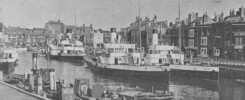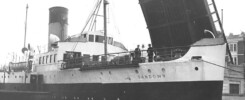Providing food and drink for the passengers was ever a part of paddle steamer operations although what was provided and how it was done naturally varied according to the route and length of journey. Short trips might have offered only a very limited fare, if in some cases nothing at all, whilst longer ones, particularly those targeted at a more wealthy clientele, would have provided substantial meals of a kind that would not have been out of place at a country house party or in the restaurants of the gradually developing network of sumptuous hotels which sprung up around the country in the wake of the expanding railway network.
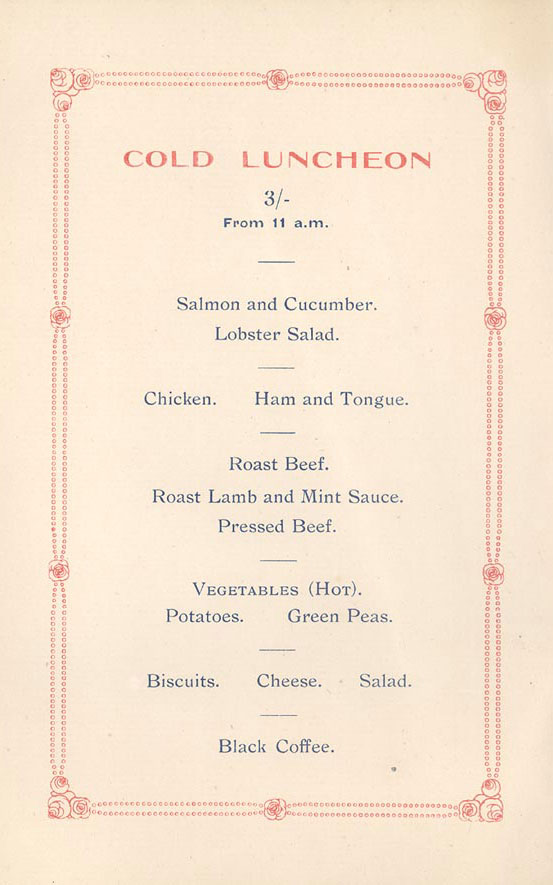
Here is a menu for a cruise on Cosens’ flagship, Majestic, on Saturday 18th July 1914 to view a Grand Naval Pageant at which HM King George V and HRH The Prince of Wales were advertised to be present. It is a pretty mouth watering affair with so many different courses and tempting delights that it makes one wonder how on earth they did it particularly given the very limited and cramped galley facilities on the steamers.
One factor of course was that by no means everybody aboard bought a proper lunch. For example, on paddle steamers which could carry five or six hundred passengers the dining saloons could rarely seat more than eighty which, even if there were three sittings, could only satisfy two hundred and forty or so hungry diners. But even that is quite a lot. Cooking for two hundred and forty needs a lot of cooking.
To ease the burden, a lot of the preparation could have been done in advance with only modest things left to do later like heat it all up just before serving. And the clue to coping with this particular Majestic menu is in the heading at the top. The words stand out in red: Cold Luncheon. So although there was a lot of cooking to prepare this substantial meal, not a lot needed to be done there and then. The delicious salmon and cucumber, lobster salad, chicken, ham and tongue, roast beef, roast lamb with mint sauce and pressed beef could all be prepared earlier with only the potatoes, peas and coffee heated up later.
Note also that the coffee here is offered black. Doubtless it was fashionable to drink coffee black in some quarters then as it is now but this was a fashion which must have suited Cosens and other steamer operators. Preventing fresh milk from going off below deck on long, warm, summer days, before the advent of widespread refrigeration and with the galley often in close proximity to the vessel’s boiler and engine rooms, can’t have been easy.
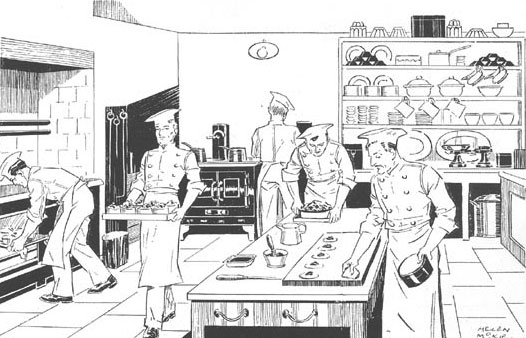
Many of the bigger companies had catering departments ashore with extensive kitchens and stores where all the real work was done. E P Leigh-Bennett recounts in “Red Funnel Stuff” in 1939:
I did more than you will ever do. I got behind the scenes of these steamers. Watched the men at work for you, whom you never see, starting very early on a busy morning. Saw them taking delivery of dozens of live lobsters, black and actively vicious, to be boiled for steamer lunches that day. Saw platoons of salmon, pink and grey perfections, and a white tiled kitchen where silversides of Scotch beef were cooking in their own juice with a most provocative smell; to be removed to a spotless cupboard in a courtyard (where a canary sang in a trill of ecstasy about nothing in particular), there to cool off alongside the forequarters of a Southdown lamb, in appetising propinquity to boulders of cheese from Cheddar. Saw plum-tarts in long array, and cakes which had been made with fresh eggs, and heard the chef’ scorn at the mention of egg powder (“the idea!”); learned that they paid eightpence a pound for their butter for all those cakes, which the cake chef said loftily was ” as it should be.” Came away – damned hungry- with the certain knowledge that I had never seen a higher quality food production and preparation, and I have wasted men’s time in the kitchens of several plutocratic liners.
Mr Leigh-Bennet continued: “But why all this care and quality? Is it appreciated?”
“Well, you see,” his Red Funnel guide replied “We have always had a big reputation for good food and drink aboard: it’s a forte of the fleet: and we are rather proud of our catering : we do it all ourselves. Where do you want to go? Bournemouth? Ventnor? Cherbourg? We have boats running to all these places.”
“They have every right to be proud. An enormous hamper of chicken arrived from a farm in Kent, and another of lettuces from Romsey just as I was leaving: a pity.”
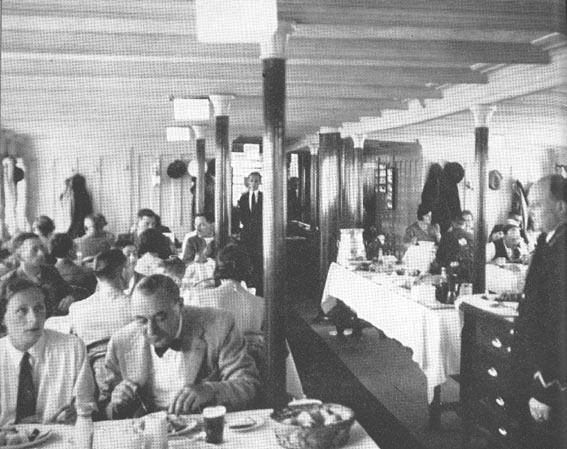
The results of all that early morning cooking are here being consumed later in the day in the dining saloon of Red Funnel’s PS Lorna Doone perhaps on a trip round the Isle of Wight or from Southampton to Bournemouth and Swanage. The Chief Steward watches observantly, ever ready for service, as a bow-tied elderly gentleman, with “Brylcreemed” hair and a bow tie, tucks into his lunch alongside his younger female companion who is decked out in a rather smart collar and tie.
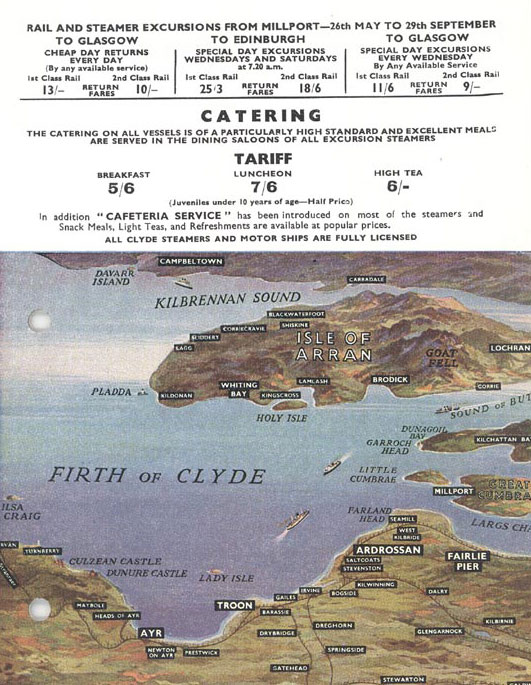
A significant reason why the numbers sitting down to a full meal on the paddlers was small in relation to the full capacity of the ships was the price. Eating aboard was not cheap. In this Clyde steamer notice from 1962, breakfast was 5/6, luncheon 7/6 and high tea 6/-. This compares, on the same leaflet, with only 4/- for a three hour “Forenoon Cafe Cruise” on the Maid of Skelmorlie (admittedly not a paddle steamer), 6/6 for a four hour cruise from Millport to Loch Goil on the Caledonia (which was a paddle steamer) and 13/3 for the all day “Round of the Lochs and Firth of Clyde” from Largs aboard the Waverley. So breakfast or high tea was almost as expensive as the full fare for an afternoon cruise on the Caledonia. And luncheon was more than have the price of the full day trip. So you had to have money to be able to afford both to pay for a trip and eat aboard.
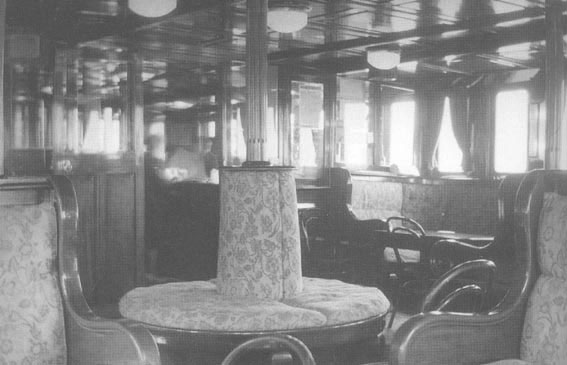
As the variety of long distance paddle steamer trips diminished, particularly after the Second World War, so too did the range and variety of food offered as well as the number expected to take advantage of a cooked lunch. For example, by the late 1950s Cosens’ paddle steamer Embassy was still running trips to the Isle of Wight from Bournemouth but it only took an hour and a half to get there and she did this is in the morning or the afternoon so the market for lunches was slim.
In order to try to appear to be more up to date and attract a different clientele, her saloon (pictured above) was given a make-over in 1964 with some of the wooden panelling you can see here replaced by cream painted peg-boarding (don’t ask!) and, to better cater for the evening Showboat Cruises, the small bar in the background was equipped with the latest in popular beers: Watneys “Draught Red Barrel” which was then all the rage with a national TV advertising campaign plugging it with the unforgettable jingle:
What’s the beer that’s always best?
Watneys Draught Red Barrel,
What’s the beer that beats the rest?
Watneys Draught Red Barrel,
Drink Red Barrel near or far
In pub or club or any bar,
It’s always good wherever you are,
That’s Watneys Draught Red Barrel!
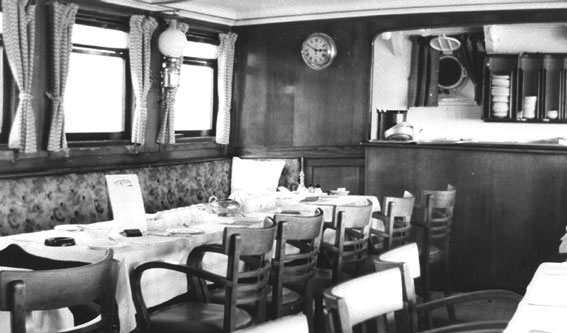
In that same era of paddle steamer decline the Medway Queen managed to keep the beacon of cooked dinners going as her trips extended over the lunch period. But the number of diners was on a slide. And where once big catering departments had pre-prepared extensive menus, by this stage, just one large joint a day was delivered to the Medway Queen and of a of a size which could easily be cooked in the galley aboard.
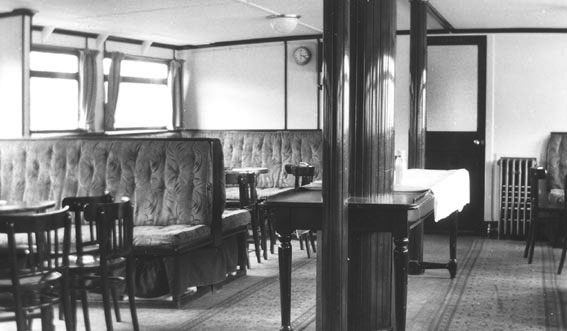
Dinners on the Princess Elizabeth became a rarity after her sale by Red Funnel into private ownership in 1959 for service first from Torquay, then Bournemouth and finally Weymouth, her steamer notices by then advertising only “Refreshment, Teas, Beers & Spirits etc”.
As you can see, like on the Embassy, her saloon (pictured above) had fixed alcove seating arranged around tables as opposed to the Medway Queen’s long communal tables running fore and aft and the Lorna Doone’s mostly athwartships. One saloon designer thinks one arrangement is best. Another has a completely different idea. The door in the background led to the Ladies’ Lavatory.
Ironically, just as paddle steamer operation was going down the pan, a new sort of catering was starting to arrive on the scene with ready made meals mass produced in factories and distributed deep frozen or chilled either to newly opening supermarkets for personal consumption or to commercial food outlets like cafes, restaurants, hotels and ferries enabling them to serve very large numbers of covers, often cafeteria style, without the need for any really skilled cooks in the kitchens at all. Suddenly putting on five hundred (chemical laden it should be said) steak and kidney pies became easy. Get a semi-trained boy to pull them out of the deep freeze in the morning ready made as delivered by Brake Bros and bung ’em in the oven. Job done. Yum yum!
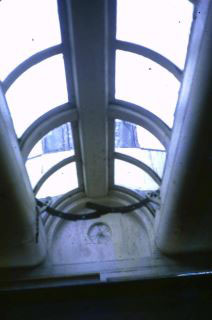
Finally, on this brief excursion through paddle steamer food, we can’t go home without taking a quick look up and out from the bar of the most beautiful paddle steamer ever built. Here we are in the forward saloon of (yes you’ve guessed it!) the Consul, in a picture taken by Peter Lamb, with the bar, usually presided over in Consul’s later years by the handle-bar moustachioed Mr George Morris, behind us. Above is the magnificent Victorian domed skylight with its curved glass windows giving a view upwards towards the bridge. Is that Capt Defrates peering back at us?
OK in her later years the Consul did not offer the high level and variety of the Majestic’s 1914 luncheon with its salmon and cucumber, lobster salad, chicken, ham and tongue, roast beef, roast lamb with mint sauce and pressed beef, potatoes and green peas. But, like the Majestic, she did do biscuits, cheese, coffee, tea, wine, bottled beers and spirits.
And, as a final tour de force, when the moon was in the right phase, the wind in the right direction and the pots full off Portland Bill with their contents ready to be snapped up at market by the amiable couple who presided over the Consul’s catering, you could buy a really first rate “Freshly Made Portland Crab Sandwich” in the aft saloon, a delectable and longed for treat, the equal in anticipation and taste of all of the Majestic’s finest fare. I’ll have another round please. No, make that two!
Iain Dewar has emailed to remind us all that the Maid of Skelmorlie (mentioned above) is still around and, named ALA, is currently laid up in Naples.
Kingswear Castle returned to service in 2023 after the first part of a major rebuild which is designed to set her up for the next 25 years running on the River Dart. The Paddle Steamer Kingswear Castle Trust is now fund raising for the second phase of the rebuild. You can read more about the rebuilds and how you can help if you can here.
John Megoran

